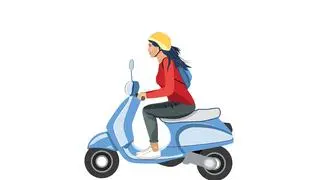With its adjustable handle, trolley wheels and lightweight exterior, the suitcase evokes style, and more importantly, the dream of a destination. With it by your side, you could be visiting a relaxing beach to sip pina coladas on a hammock or you could be moving to a new city to start an exciting chapter in life. Possibilities seem endless with this wonderful invention, which promises to uplift your status and lighten your load.
The suitcase initially began quite literally as a case for suits, shirts and hats in the Western world in the late 19th century. It was only when leisurely travelling became available to the masses that the suitcase really caught on as luggage and spread to the rest of the world.
In India, luggage has come a long way from weighty iron trunks and boxes, the petis and baksas. Decades ago, travel wasn’t as accessible and simply meant yearly pilgrimages and long trips to the village. Together, members of the joint family lugged their heavy petis in buses and trains. If you could afford it, you could request a coolie to come to your aid. When the trip was over, the peti could be upholstered with a bedsheet and cushions to create a makeshift settee in the living room. Paisa vasool, indeed.

Indian luggage is incomplete without the mention of the humble VIP attaché. It symbolised a slight break from tradition and plodded on with the Indian nuclear family. The grey attaché mirrored their shared bonds. Everyone’s clothes were folded and stacked into it. The father, carrying it, led the family as they marched along to the train station.
The duffle bag also entered the luggage world soon after and put a foot in the door for individuality. It also signalled the beginning of travelling for leisure, in the form of a few family trips. Sometimes, you could have a duffle bag entirely to yourself and sometimes you shared it with your family. You could team up with your sibling and hold it by a strap each to share the weighty load. Interestingly, the duffle bag and its predecessor, the attaché, were popular not only among travellers, but also criminals and gangsters due to the mobility they afforded. This is evident from several crime films in the 1950s which featured luggage full of stolen money.
The duffle soon passed the baton to the trolley suitcase. Lo and behold, everything changed. The suitcase swept its way into the middle class family as they took their first plane journeys. Every member of the family now owned a suitcase, from the tiny toddler to the aged matriarch.
Trolley suitcases are also unisex, because they are easy to carry. In parts of the world where patriarchy remains fairly unchallenged, even owning a suitcase can become a radical metaphor for women. It can mean mobility and freedom to choose for oneself. Funnily enough, men who belittle women’s capabilities have reported an increase in women telling them, “Thanks for the help, but I can handle my own suitcase.”
The suitcase has brought winds of change to herald aspiration, independence and personalisation. If you’re zipping away for a quick business meeting, let the tiny cabin suitcase help you. If you’re getting married, how about those matching sets of suitcases? And if you’re a tech-lover, there is a motorised suitcase with built-in USB port. Your suitcase could be waterproof, anti-breakage, anti-theft, ultra-light in any colour you like.
To put it simply, no destination is too far and no possibility is far-fetched, so long as you have the right suitcase zipping along.
(Hamsini Shivakumar is a Semiotician and founder of Leapfrog Strategy. Khushi Rolania is a senior research analyst at Leapfrog Strategy.)













Comments
Comments have to be in English, and in full sentences. They cannot be abusive or personal. Please abide by our community guidelines for posting your comments.
We have migrated to a new commenting platform. If you are already a registered user of TheHindu Businessline and logged in, you may continue to engage with our articles. If you do not have an account please register and login to post comments. Users can access their older comments by logging into their accounts on Vuukle.